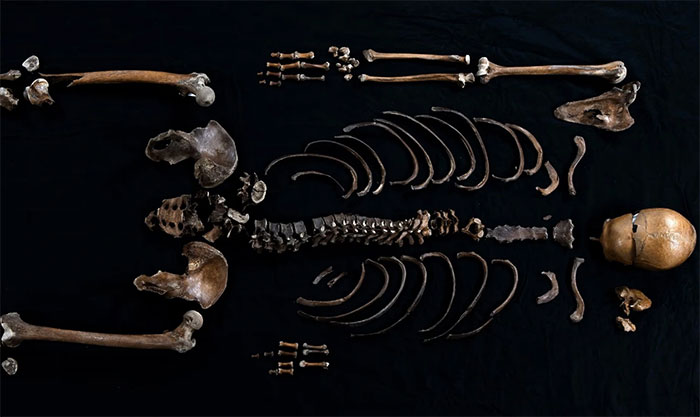Remains suspected of being of character appearing in epic over 800 years ago
Studies have shown that the discovered remains most likely belong to a character who appeared in a Norwegian epic more than 800 years ago.
The Guardian reported on October 27 that a recent study of the remains found in the city of Trondheim (Norway) showed many similarities with the character who appeared in the Norwegian epic. Accordingly, Mr. Michael Martin, Norwegian University of Science and Technology, co-author of the study, said: 'Although we are not 100% sure, the scientific evidence and context are very convincing'.

The remains of the "man in the well", suspected to be a character in the Norwegian epic Sverris. (PHOTO: SCREENSHOT FROM THE GUARDIAN).
Scientists believe that the remains are those of a person mentioned in the epic poem Sverris in 1197. The epic poem , which consists of 182 verses, tells the story of the Norwegian King Sverre Sigurdsson, who ruled the kingdom during a period of political unrest and civil war. One passage describes an attack by enemies on King Sigurdsson's fortress at Sverresborg (today's Trondheim). The attackers surrounded the castle, took all the goods, and burned every house. They captured a dead man, threw him down a well, and filled the well with stones.
Historians believe that if the story really happened, the man thrown into the well belonged to a group of soldiers defending the city, known as Birkebeiner. According to a study published on iScience on October 25, scientists analyzed most of the remains excavated in 2014 - 2016 at the well, and determined that it was highly likely that he was the Birkebeiner man in the epic story.
Using radiocarbon dating of the skeleton, the researchers determined the radiocarbon age of the remains to be 940 years, with a margin of error of 30 years. This coincides with the time of the siege of Sverrisborg in the epic Sverris.
DNA analysis showed the person had blond or light brown hair and green eyes, suggesting he may have come from southern Norway.
Researchers believe this may be the first time they have recovered genetic information from a character appearing in an epic, with the possibility of a real person.
'We've shown that epics aren't as fictional as the public perceives them to be. I think this helps people appreciate the content of epic stories ,' said Michael Martin.
- Planet where people can live 150,000 years
- Young stars abruptly reduce their light, aliens are suspected of being the culprits
- Mysterious aliens in epic Gilgamesh
- Recovering epic labyrinth over 1,000 years
- Marvel new exotic planets in honeycomb clusters
- The erosion coast reveals six remains hundreds of years old
- 1-year time-lapse video passed on Earth from NASA's EPIC camera
- The mystery of treasure in the epic Homere.
- 'Unparalleled treasure' from 44 mysterious remains in a stone pit
- Nuclear war ever occurred prehistoric times?
- Discover the remains of women bent over 4,000 years in the grave
- Indian officials claim the Internet was invented in curry!
 Discovered an ancient centipede fossil 99 million years old
Discovered an ancient centipede fossil 99 million years old Discovered bat-like dinosaurs in China
Discovered bat-like dinosaurs in China Discovered a 200-year-old bronze cannon of the coast
Discovered a 200-year-old bronze cannon of the coast Discover 305 million-year-old spider fossils
Discover 305 million-year-old spider fossils